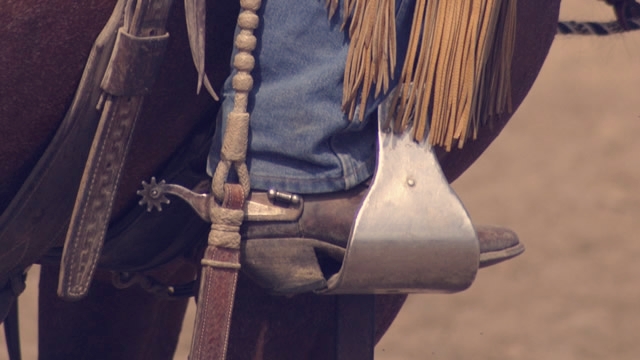Written by Martin Black
This article originally appeared in Eclectic Horseman Issue No.48
People often ask about spurs—when or if they should use them. I think it depends on the individual and “when or if” they can control them and “when or if” they are aware of when they are using them.
To me spurs should not be used as the primary signal. First the horse should feel some life or rhythm in our body or legs if we want him to accelerate. If we are asking the horse to move off one leg, we can still put some life in one leg first. If the horse does not respond to the leg or legs, then reinforcement can come with the spur.
Squeezing can be effective. If it is that’s fine. The problem that can come from squeezing is that the horse may not realize enough reward. The rider squeezes as the horse’s foot leaves the ground and as the foot sets down. Or in another situation when we want to go from point A to point B and we are going to release at point B. But as we depart point A, the horse doesn’t get any hint of there being any relief at point B, so he figures why work for point B when there is no sign it is going to be any better than point A. He just learns to tolerate the discomfort. There needs to be some incentive for the horse.
There should be enough respect or even intimidation for the spur that we rarely need to use them. When the horse gets too comfortable with the spur or “desensitized,” we can have numerous problems. Besides the obvious that he ignores the request made with the spur, he can get resentful to the point of switching his tail, or even kicking or bucking.
Now, having said that, we must be sure that the horse first understands our request. If we are forcing something on a horse he doesn’t understand, we can cause all kinds of problems. He has to understand where we want him to go. It doesn’t do any good to hurry if we are headed in the wrong direction. We will just get to the wrong place faster.
The principle of maintaining respect with your spurs is simple: Don’t say it if you don’t mean it. Like the little kid that learns what “Hot” means, you can warn him to stay away from the hot stove, you can reason with him, explain what will happen, and the more involved you get the more blame and resentment you’ll get when he gets in trouble or burned. On the other hand, tell him to stay away from the stove it’s “Hot” and if he doesn’t, at the peak of his discomfort say “Hot” loud and clear so he clearly understands “Hot” means pain and discomfort, stay away. If the timing is right and he relates the results to his action, there will be no resentment because he did it to himself. He understands what got him into trouble and what got him out.
As for the spurs, the life in our leg or legs, is the warning “Hot,” and the contact with the spur is the burning sensation. We can measure how much we burn the horse; he probably does not need third degree burns on ninety percent of his body. He may not even need a small blister. If a slight red mark is effective and understood, that’s all we need. Do what it takes. If you do too much, he may panic. If you don’t do enough, you may cause resentment or be ignored totally.
We can start with an increased rhythm in our body, and or fanning or bumping with our calves. If that is not effective, we can then bump him with the side of the stirrup. Sometimes the surprise of a good slap will be effective; a slap on the horse’s elbow will have more effect than on his ribs or shoulder. A spank on the rump can also reinforce the meaning of the life in the legs.
The spur should come last and it should be the last thing you say to your horse.
Regardless of what we do to cue the horse, if we ask for something in the same way more than about four times, he will usually start getting desensitized. The first signal should call his attention; the second will measure the response and tell if there needs to be a third and determine if it needs to be less, the same, or more. If it needs to be more, make sure the third time he acknowledges it was more so he doesn’t ignore it and get desensitized. If you’re not right on, it’s better to be on the side of being too strict. You will still have respect. If you are on the side of nagging, you will have resentment.
The horse can be resentful and buck you off or he can get scared and buck you off. Either way the ground can be just as hard. We need to be somewhere in the middle, effective and understood.
This article originally appeared in Eclectic Horseman Issue No.48 Subscribe today.


